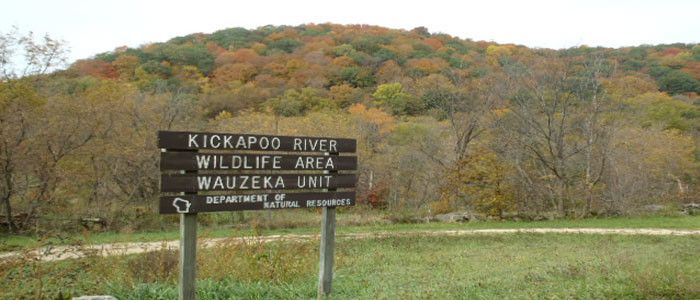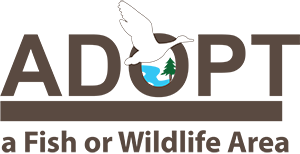Kickapoo River Wildlife Area - Wauzeka Unit

Kickapoo River Wildlife Area-Wauzeka Unit is a 5,697-acre property (1,927 acres state-owned and 3,770 acres of private lands under easement for hunting and fishing only) located within the Lower Kickapoo and Kickapoo Conservation Opportunity Area in Wisconsin's Wildlife Action plan [PDF]. The habitat on the property is of continental significance for its driftless area features. The property is also an Important Bird Area [exit DNR] because the forests in the southern portion of this site are among the largest and most intact in the whole driftless area and contain significant populations of forest interior birds such as red-shouldered hawk, Acadian flycatcher, wood thrush, cerulean warbler and Kentucky warbler. Prairie and savanna habitats host Bell's vireo, brown thrasher, blue-winged warbler, field sparrow, bobolink and eastern meadowlark. Thousands of migrants use the area, particularly in spring. The Kickapoo Wild Woods State Natural Area is found within the Wauzeka Unit.
The property began as a perpetual hunting and fishing easement unit of the lower Wisconsin River Wildlife area in 1968. In 1975, the Kickapoo River Wildlife Area was separated from the lower Wisconsin River project and conversion of easements to fee ownership was begun.
The Wauzeka Unit contains one of the largest blocks of oak forest in Southern Wisconsin and supports the associated forest interior bird species and many migrating songbirds in the spring and fall. The Kickapoo River runs through the unit and provides paddling opportunities with county-maintained canoe launches in nearby towns. Waterfowl and furbearing mammals inhabit the associated backwaters and wetlands, which transition to forested uplands with various aspects. High-quality prairie remnants are found on the south and west-facing hillsides, which are dominated by oak and hickory. The forest stands provide habitat for deer and small mammals. Large ridgetop fields in the southern portion of the unit are being converted to native prairie and savanna communities.
Find the area 1/2 mile north of State Highway 60 on State Highway 131.
Management Objectives
The Wauzeka Unit contains one of the largest blocks of oak forest in Southern Wisconsin and supports the associated forest interior bird species and many migrating songbirds in the spring and fall. The Kickapoo River runs through the unit and provides paddling opportunities with county-maintained canoe launches in nearby towns. Waterfowl and furbearing mammals inhabit the associated backwaters and wetlands, which transition to forested uplands with various aspects. High-quality prairie remnants are found on the south and west-facing hillsides, which are dominated by oak and hickory. The forest stands provide habitat for deer and small mammals. Large ridgetop fields in the southern portion of the unit are being converted to native prairie and savanna communities.
Notable feature: The Wauzeka Unit is a site of an active University of Wisconsin-Madison Department of Forestry oak management study.
Visit the property planning for more information on master planning for this and other wildlife areas around the state.
Recreation
The Kickapoo River Wildlife Area-Wauzeka Unit offers many recreational opportunities:
- Birding (birds commonly seen include woodland songbirds, great white egrets and bald eagles)
- Canoeing
- Cross-country skiing (no designated trail)
- Fishing
- Hiking (no designated trail)
- Hunting (noted for: waterfowl, squirrels, deer, wild turkeys and furbearers)
- Trapping
- Wild edibles/gathering
- Wildlife viewing
Note: The easement properties are privately owned, and the only allowable uses are hunting, fishing and trapping on some parcels. See the Wildlife Area Easements in Crawford and Richland Counties document for more information.
Amenities
- Bathroom - none.
- Parking lot - there are six parking areas throughout the property.
- Campground and size - none.
- Trails, Types and Lengths - none.
Maps
Download [PDF] a map of this property.
If you are interested in exploring this property further, you can access an interactive map.
Find out more about how to adopt this wildlife area.

